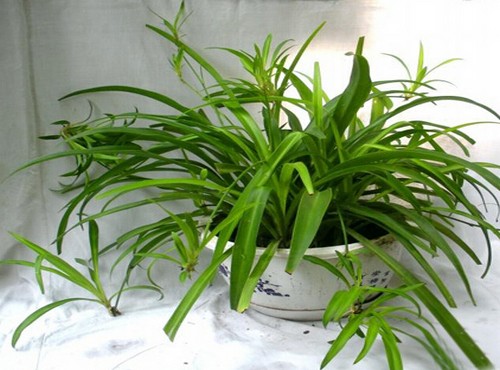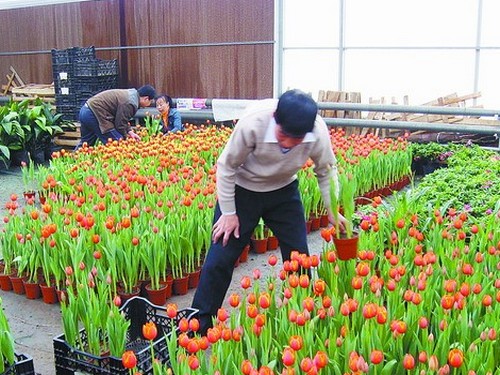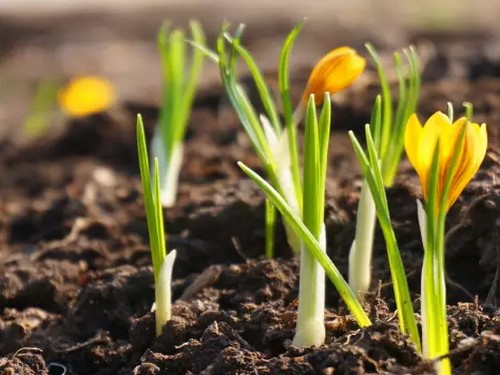Planting techniques of potted orchids in family
Chlorophytum is not only an excellent pendent foliage plant in the room, but also a good indoor air purification flower. Chlorophytum has a very strong absorption of toxic gases, so chlorophytum also has a "green purifier" laudatory name. The most prominent feature of spider plants is that mature plants occasionally grow stems, flower pavilions are slender, longer than leaves, and drooping; racemes are simple or branched, and sometimes clusters of 2-8 cm strips of leaves grow on the upper nodes of the inflorescence. Flowers bloom in spring and summer, and indoors in winter. Let's learn about the method of planting spider orchid together with Xiaobian.

Sexual preference warm and humid, semi-overcast environment. It is adaptable, drought resistant and cold resistant. Do not choose soil, in loose sandy loam growth better. Light requirements are not strict, a boat suitable for growth in moderate light conditions, but also resistant to weak light.
In addition to winter temperature is too low to be suitable for plant division, other seasons can be carried out. Potted 2-3 years of plants, in the spring when the pot will be dense seedlings, remove the old culture soil, divided into two to several clusters, respectively potted into new plants. Chlorophytum can also be propagated by small plants on the stem. In the growing season, the small plants on the stems are cut off, planted in culture soil or water, and transplanted into pots after the small plants grow roots.
Chlorophytum pot commonly used moldy soil or peat soil, garden soil and river sand equal mix and add a small amount of base fertilizer as substrate. Change the pots every 2-3 years and recondition the culture soil. Its fleshy root water storage tissue developed, drought resistance is strong, but 3-9 months growth peak period water demand is larger, to often water and spray, in order to increase humidity.
Nitrogen fertilizer is the main fertilizer, but Jinxin and Phnom Penh varieties should not apply excessive nitrogen fertilizer, otherwise the line spots on the leaves will become less obvious. Chlorophytum like semi-shady environment, such as the place where the light is too strong or insufficient, the leaves will easily become light green or yellow-green, lack of life, lose its ornamental value, and even die.
Indoor cultivation of spider orchid should pay attention to the following 8 points:
1. Substrate: Chlorophytum has strong adaptability to various soils and is easy to cultivate. Available fertile sandy loam, humus soil, peat soil, or fine sand soil plus a small amount of base fertilizer for potted soil.
2, reproduction: usually with the division of the plant method of reproduction, in addition to the winter temperature is too low is not suitable for division, other seasons can be carried out. Can also be cut flower stems with air root seedlings potted another culture.
3, light: hanging orchid happy semi-shady environment, can be cultivated in bright indoor all the year round. Often cultivated indoors, should avoid direct sunlight, need to cover 50~70% of the sunlight. In this way, it can grow luxuriantly and the leaves are beautiful.
4, temperature: spider orchid high temperature resistance. The suitable growth temperature is between 15-30℃, and the winter overwintering temperature is above 10℃.
5, humidity: like humid environment, in order to make the spider fresh and green, you can often spray water to the leaves.
6, watering: hanging orchid love wet environment, pot soil easy to keep wet often. However, the fleshy roots of the crane can store a lot of water, so they have strong drought resistance and will not dry up for several days without watering. Winter 5 degrees below, less watering, pot soil not too wet, otherwise the leaves easy to yellow.
7. Fertilization: Liquid fertilizer is applied every 2-3 weeks during the growing season. Variegated varieties should apply less nitrogen, otherwise white or yellow markings on the leaves will become less visible. Stop fertilizing when the ambient temperature is below 10 ° C.
8, pruning: usually cut off yellow leaves at any time. May turn over the basin once a year in March, cuts off the old root, the rotten root and the redundant fibrous root. Cutting off some of the old leaves in the early and middle of May will promote the germination of more new leaves and small spider plants.
Time: 2019-05-25 Click:
- Prev

Planting methods and techniques of Tulip
Many friends have asked the editor how to plant tulips. Now the editor has sorted out the planting methods of tulips so that everyone can take better care of their beloved tulips and let them bloom beautifully in the coming year. 1. Prepare the basin and soil: the basin is not too large, the best depth is 20 cm.
- Next

Planting method of potted saffron
Saffron, also known as saffron, saffron, and so on, many farmers do not grasp the key technical points, resulting in longer and smaller bulbs, fewer flowers, lower and lower yield per mu, and give up planting because of inefficiency. With the crocus in full bloom, the pace of spring is getting closer and closer to us.
Related
- Fuxing push coffee new agricultural production and marketing class: lack of small-scale processing plants
- Jujube rice field leisure farm deep ploughing Yilan for five years to create a space for organic food and play
- Nongyu Farm-A trial of organic papaya for brave women with advanced technology
- Four points for attention in the prevention and control of diseases and insect pests of edible fungi
- How to add nutrient solution to Edible Fungi
- Is there any good way to control edible fungus mites?
- Open Inoculation Technology of Edible Fungi
- Is there any clever way to use fertilizer for edible fungus in winter?
- What agents are used to kill the pathogens of edible fungi in the mushroom shed?
- Rapid drying of Edible Fungi

